
ianskipworth.com > wanderlust > Skip en Sudamérica - Part 1
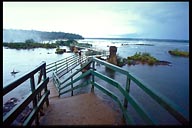 |
Skip
en Sudamérica
is a diary of sorts which follows the travels of Skip through South America
between late April 2000 and mid September 2000.
Two nights before, I slept cozy in my own bed, tucked beneath 2 down quilts,
with Vibi the cat curled up, purring at the foot of the bed. All was comfortable
and secure.
My next night's sleep on terra firma was spent in a small cramped room
with five other backpackers at El Hostal de San Telmo in central Buenos
Aires. All was no longer comfortable and secure but there was now a certain
unpredictability and excitement to life that I seldom experience at home.
The flight from Auckland
was uneventful apart from periods of turbulence but these don't seem to
freak me out the way they used to. After having the check-in guy in Auckland
tell me I would have problems with not having an Argentinian visa or flight
out within 3 months, I was processed by immigration with a minimum of
fuss and released wild into the new continent.
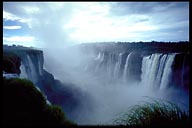 |
I'd met two Kiwis,
Mark and Matt on the plane and persuaded them that the cheap local bus
was THE way to get into the city. After enduring 2 hours on the bus, looping
through every possible detour between airport and city, they were suggesting
to me that they would rather have paid the 10 times higher fare for the
express bus. Not me! I'm a real backpacker or at least I will be once
I get used to the stink of the others in my room.
That night, I relaxed
in the delightful surroundings of the Plaza Dorrego with Mark, Matt and
an English girl, Lisa. In this area the streets are narrow and the buildings
built vertically from the footpath for 2 or more stories. The buildings
are old and to me, very much reminiscent of what you might find in the
older parts of a French city. The whole place has a very European feel
but many things are a bit shabby with buildings typically in a poor state
of repair. At an outdoor cafe in the Plaza Dorrego, I broke the 6 month
alcohol drought and had a few beers. Whether or not this establishes a
permanent break to the drought remains to be seen but if I can abstain
from this, it will greatly assist with the budget which is finding itself
under pressure already. The local currency here is effectively the US
dollar. Money machines dispense both dollars and pesos, $1 = 1 peso, and
things ain't cheap.
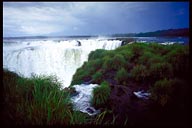 |
The weather has been
warmer than I expected. It's certainly warmer than Auckland was and if
I could, I'd be wearing shorts and T-shirt everywhere. It seems safe too.
Staggering about the back streets near the hostel at night feels absolutely
fine. The bustling train station today felt a little less friendly but
they haven't got me yet!
Porteños (residents
of Buenos Aires) are night owls. On my second night in Buenos Aires, Matt,
Mark, Lisa and I stayed out until about 3am. At this time the local bars
were swarming with people. Many restaurants didn't even open their doors
until 9.30pm or later. The next morning I over slept until about 11 and
failed to meet up with Matt and Mark as planned. The weather had turned
miserable and it drizzled steadily throughout the day. I was getting fed
up with the crappy accommodation in the cramped dormitory room and the
weather and wanted to at least book a ticket out of BA. At the huge Retiro
bus terminal I established (using my pathetic pigeon Spanish) that the
bus I wanted to take the next day to Puerto Iguazú was fully booked. I
opted instead to soothe my itchy feet by booking a ticket on the bus that
night.
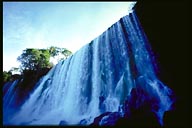 |
With hindsight I regretted leaving BA so quickly as I missed the chance to to visit La Boca and other interesting barrios (neighbourhoods), and never photographed any of the street performers dancing the tango. Instead, I jumped on a bus at about 7pm for a 16 1/2 hour overnight trip to Puerto Iguazú. I've had lots of crappy bus trips - this wasn't one of them. The seats were like giant lazy-boys with plush leather upholstery. With only 3 seats in width across the cabin, they were wonderfully spacious and reclined to near horizontal. We were served airline type meals with wine and I slept surprisingly well. I awoke briefly during the night to watch the sky fill with lightning every few seconds.
 |
The next day, I visited the Argentinian side of the Iguazú Falls (Cataratas del Iguazú). My first view was most impressive and immediately reminded me of the Victoria Falls. My memory of Vic Falls is not good but what memories I do have would rate Iguazú as a greater spectacle. Iguazú actually consist of dozens of falls which need to be viewed from many different vantage points on both the Argentinian and Brazilian sides of the border.
My companion on the
Argentinian side was Sacha, a French guy with toffee nosed accent from
an English public school and Oxford education. His Spanish and linguistic
worldliness in languages including Russian made me feel all the more inadequate.
It rained all morning but we got some good weather in the afternoon and
near sunset, watched dozens of Toucans feeding in the tree tops.
 |
The following day I made my way across the Brazilian border and wandered about the falls there in constant rain. The panoramic view from the Brazilian side complemented the more intimate views from the previous day. Families of semi-tame Coatis, a raccoon like animal, waddled about the area, apparently fat from over feeding by tourists. After two nights in Puerto Iguazú, the feet had begun to itch again and after listening of others' plans to head for Rio de Janeiro, I decided it would be silly for me to miss out on one of the world's great cities. The 22 hour overnight bus ride took us through well developed farmland and past large cities that hardly rated a dot on the map of this massive country.
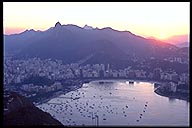 |
Rio greeted us with
26 degrees, sunshine and the craziness that all really big cities possess.
My accommodation in Copacabana with Robert, a yank, Jim, an Aussi and
Dave, a Kiwi located us in the most expensive piece of real estate in
this country of 165 million people. It's a weird place. Robberies are
very common in this area but it feels safe enough during the day. At night,
you could walk a few blocks and almost guarantee to be robbed.
Getting to know Rio
took a while. Its beauty seduced me immediately but it's such a crazy
place that I wouldn't be sorry to say good-bye.
Our accommodation was just a few hundred metres from the Copacabana Beach.
On the first
day in Rio, we wandered down there and relaxed with some beers on the
promenade. When the weather is good, the beach fills up with locals soaking
up the sun, swimming and playing beach volleyball. I went swimming on
only one day and was probably the palest skinned person amongst thousands.
The water was of comfortable temperature but the big, dumping waves and
strong undertow made it less than relaxing. Security is a bit of a problem
too as possessions unguarded for even a minute tend to go missing.
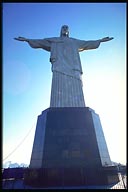 |
The highlight for me was the cable car ride to, and views from the Sugarloaf (Pão de Açúcar). Robert and I headed up there mid afternoon and spent probably two hours admiring the view of the city, watching the sun set, and then watching the city slowly start to twinkle at night. The dozens of bays, beaches, rocky islands and tumbling wooded mountains make for a magnificent setting difficult to compare with any other city I've seen.
The following day we went up to the other major vantage point - Corcovado, topped by the massive statue of Christ the Redeemer. Although considerably higher than the Sugarloaf, the view didn't seem as impressive and we were too tired and hung over to stay up there long. Like Buenos Aires, night life doesn't start 'till late. Brazilians are of very mixed racial origins with black skinned Africans, pale skinned Europeans, and everything in-between. The hookers however are almost all black. Late one night, we wandered down the promenade and stopped for a while at a busy café for a beer and to watch the weird (human) creatures prance about. One of my companions was so taken with them that he could not resist the obvious temptation. He took her(?) back to our room and did the business (I presume). When the rest of us arrived back we had to wait to get in. This wouldn't have bothered me much but I was concerned that my possessions and money belt in the room might not be safe.
 |
On the Sunday, we
caught a bus down to the next beach from Copacabana, Ipanema. There, we
spent a very pleasant few hours wandering down the the promenade with
thousands of locals out for a Sunday stroll. Big swells rolled into the
beach there and would have made swimming unpleasant if not dangerous.
That
evening we headed off to a soccer game at the huge Maracanã stadium.
For one of the world's biggest stadiums (perhaps the biggest), it was
surprisingly intimate. The game was a fairly big local derby I think :
Flamengo vs. Fluminense and the stadium seemed about 2/3 full. Positioned
in the middle of the Flamengo supporters section, the atmosphere was fucking
incredible. With 50,000 or more Flamengo fans singing and clapping in
unison and a sea of huge waving flags and smoke bombs, it was an experience
not to be missed. When Fluminense went 1-0 up, the mood of our supporters
was starting to sour. The equalizer came just before half time to riotous
celebration and the game thankfully finished up with a 3-2 win to Flamengo.
On the way out we were caught in a sea of people and got quite badly squashed
in the crowd - not a pleasant experience.
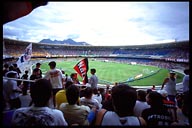 |
Rio was cool but it
felt good to escape its craziness. From Rio, I headed across a small corner
of the big country to Corumbá on the Bolivian frontier. The 26 hour bus
trip was the longest yet but passed with little discomfort. Once away
from the coast, the countryside was less well tamed or perhaps just less
well suited to intensive agriculture. The flat savannah with patches of
scrubby vegetation or stunted forest continued for much of the journey.
As we approached the Pantanal, a similar landscape continued but began
to be broken up by areas of swamp or lagoons.
On arrival
in Corumbá the bus was met by the not uncommon rabble of touts trying
to lure any Gringos on the bus to their tour or hotel. I hadn't been planning
to see the Pantanal, just to pass through on my way to Bolivia, but two
other Aussi Gringos on the bus seemed half keen on a tour and I tagged
along with them to explore the possibility. After listening to the agent's
spiel and having a few relaxing beers, we decided to leave the next morning
on a 4 day, 3 night Pantanal tour.
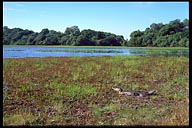 |
The Pantanal is a
vast wetland area located mainly in south western Brazil but spilling
over also into neighbouring Paraguay and Bolivia and is one of the best
places on the continent to see wildlife. From Corumbá we traveled for
about 5 hours to our camp site in an incredibly dilapidated 4WD. That
this piece of shit 4WD, an old Toyota Landcruiser, in such an obviously
poor state of repair (having been patched up a hundred times by bush mechanics
with few more tools than the rocks and timber that lie beside the road)
went at all is testament to the way the Japs built the thing. It was fucked
but it just kept going like it didn't want to die.
The camp site was set within a thicket of trees beside a tranquil lagoon.
On arrival we were hot, sweaty and dusty and soon went for a swim in the
lagoon. The water was warm and clear although stained brown like tea.
Small tropical fish of various types swam around us. In this lagoon and
probably in most others, there were many crocodiles and Piranha but the
crocodiles (actually caiman I think) are no bigger than about 4 feet and
the Piranha too small to give you anything other than a gentle peck. We
spent quit some time exploring the area on foot and saw plenty of wildlife
including crocodile, capybara, coati, armadillo, deer, monkeys, and bird
species too numerous to try to mention.
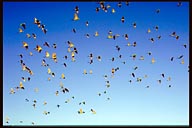 |
We saw bugs too. The
Pantanal seems to be a damn good place to see mosquitos, various other
stinging flies, stinging ants, ticks, fleas and these little burrowing
shits that crawl into the skin around your toe nails. After a few days
the little burrowing shits have sucked enough out of you to produce eggs
and make your toe sore. I hope I dug them all out. I remember reading
that you can't get malaria from one mosquito bite. I hope they meant one
thousand bites because I got plenty. I did my best to cover up and use
repellent but still got eaten alive on several occasions.
On the last day in the Pantanal, we went on a horse ride and I was reminded
that I´ll never be a horse person. When it walked it was OK, when it trotted
it hurt, and when it galloped I was filled with fear knowing that it was
only a matter of time before I'd lose my balance and fall off. Miraculously,
the piece of shit 4WD carried us safely back to Corumbá after a flat tyre
stop and after losing a u-bolt holding the rear tray to the chassis (proficiently
repaired with a piece of rope).
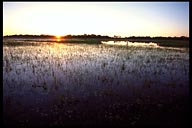 |
The next day several
us us Gringos decided to make a run to catch the train which departs just
across the frontier from Corumbá and heads for Santa Cruz in Bolivia.
After several panicked taxi rides we finally made the train with a minute
to spare before it departed. It was a rather uncomfortable night on the
train, filled frequently with yelping kids selling food and various other
commotions but I arrived early the next morning in Santa Cruz and was
damn please to be there.
I stayed a
couple of nights in Santa Cruz hanging out mainly with a German couple,
Inti and Ines. I have been reasonably fortunate in my travels to meet
up with good companions. There's certainly no shortage of potential companions.
The problem is rather that a lot of them are not quite my cup of tea.
Typically, backpackers are 10 or 12 years younger than me and tend to
travel round in groups. The group thing is fine but when you get more
than 2 or 3 people it usually becomes a pain in the arse. I can't stand
hanging around with a group of say 6 where everybody always seems to be
waiting for one of the group to do their thing. The age thing isn't really
a problem - when I did this thing 12 or so years ago, I remember the same
frustration. I never did like hanging around with cliquey groups. However,
I do find that some of the younger people tend to be fuck wits and that
the more mature (old bastard) travelers like me generally suit me better.
In Santa Cruz we just hung out for a couple of days and did little of
particular note other than had a good night out where we went to a pretty
swanky night club where after sampling the atmosphere and an expensive
beer, went on to look for something cheaper. The town seemed to be completely
closed at about 1 am but we eventually found a rather seedy bar filled
with pissed locals. They didn't sell beers there, only a kind of home
brewed rum which was reasonably palatable when mixed with Coke. It was
a good night starting off in probably the swankiest, most western joint
in town and ending up with sing songs with the pissed locals in this seedy
drinking den.
Bolivia has in general been a lot more civilised than I expected. Although
it is perhaps the poorest country in South America and very cheap to travel
in, the infrastructure is certainly better developed than almost every
one of the 20 something African countries I visited 12 or so years ago
(with the notable exception of South Africa).
 |
The 18 hour bus trip
from Santa Cruz to La Paz passed through some interesting country, especially
towards the end of the trip. La Paz, at about 3800m (12,460 ft) is the
highest capital city in the world and is certainly noticeably cooler and
dryer than the lowlands. With La Paz located in a canyon, the first view
of the city from the rim of the canyon is spectacular and unforgettable.
Some people experience altitude sickness after arriving here from lower
altitude but it didn't seen to affect me much except for some shortness
of breath while trudging up the many steep city streets. Wandering around
the city at leisure is a relaxing and colourful experience with the colonial
architecture, many markets and those fat old Indian women with their bowler
hats. The day after arriving in La Paz, I checked out a Spanish language
course and enrolled in a one week course.
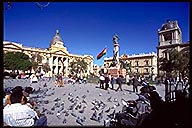 |
La Paz seems to be
any easy place to get stuck in for a while. My excuse for staying is the
Spanish tuition which I've been taking but other backpackers seem to hang
out here and do almost nothing except party at night. My Spanish tuition
certainly taught me a lot but 7 days just isn't enough. I would like to
continue with it but although La Paz is a cool city, I get weary of it
and want to move on to see new things. The Spanish tuition is relatively
expensive but living costs are so darn low that even with the cost of
the tuition included, I can still live within my budget. In other terms,
the daily cost of the tuition alone would pay for accommodation, food,
beer, and one gram of cocaine. If reduced to the bear necessities, you
could have 2 grams of coke. Of course, I chose to forego the coke so I
could afford the Spanish tuition. La Paz is cool but I'm getting tired
of feeling lethargic and panting my way up the steep streets. The altitude
has never affected me badly but it doesn't seem to be getting any better.
If anything it's worse and I'm looking forward to getting back into some
thick steamy air much nearer to sea level.
 |
We went to a soccer match one night in La Paz. The stadium was absolutely packed for a South American club competition between a local team, Bolivar, and a Mexican team, América. We arrived way too late and the stadium was absolutely packed. With great difficulty we found some cramped standing room right at the very top of the stadium. About 10 minutes into the game I started seeing stars and the next thing I remember I was on my arse with a local frantically flapping a seat cushion in my face. Prior to this, the locals had jealously guarded their space but then made room for me to sit and offered me coffee and Coke (that's Coca Cola). The stadium was very full but I think it had nowhere near the capacity of the Maracanã in Rio. The local side, Bolivar, lost 2-1 which didn't encourage festivities but I thought the frenzied atmosphere in Maracanã was way better.
 |
A popular sightseeing
activity in La Paz is a visit to the San Pedro prison. This somewhat bizarre
attraction is a working prison. Like most or maybe all South American
prisons, it's very over crowded. It's capacity is 600 but it houses 1800
inmates and a total population of about 3000. The 1200 extra people are
families of the inmates and service providers. Inside the prison there
is pretty much a self contained community with shops, restaurants, prostitutes
and probably almost anything you can get on the outside. With money, the
inmates can get anything. Those with money are able to buy quite nice
rooms and order in food or anything they want from outside. On special
occasions, can buy their way out unescorted for the night for $100. There
are no guards inside and the admission fee we pay must be partially distributed
amongst the guards at the gate to allow tourists in. The first place you
are taken inside is a little room where inmates are packaging cocaine
that you can buy. You can buy guns also and apparently murders take place
regularly. It all sounds crazy and it is. You almost have to wonder whether
it's set up purely for the tourists.
After having spent
11 nights in La Paz I finally made my escape on an overnight bus to Uyuni
in the south west. I had tried to leave the day before but student protests
prevented buses leaving the city.
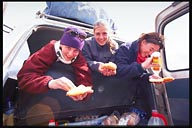 |
Much of the road to
Uyuni is pretty crappy - some of it nothing more than a bumpy dirt track
full of corrugations and water eroded channels. During the journey we
had to disembark from the bus in the middle of the night to allow it to
negotiate a particularly tricky bit. The moon and stars were beautiful
but my already chilled limbs almost seized completely in the icy cold
conditions. We spent one night in Uyuni, just a small, cold, dusty town
set on a barren plain but surrounded by distant mountains, before setting
off on a 4 day tour of the nearby salt plain, Salar de Uyuni, and various
lagoons further afield.
All of this stuff is on the Altiplano with a base level of 3,500 to 4,000 metres (11,500 to 13,120 ft). The many mountains don't soar spectacularly for miles above this but with heights approaching 6,000 metres (19,680 ft), they're high peaks by world standards. I seem to now be fairly well acclimatised to the altitude but the cold will never be easy to bear. When it's fine, it's quite pleasant in the direct sun but in shadow or at night, you really have to ask yourself why you chose to be in this place.
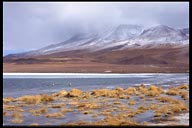 |
The Salar de Uyuni
is a massive salt plain with mile upon mile of dazzling white crystallised
salt. In the middle of the salar, we stopped at a bizarre rocky outcrop,
Isla de Pescado, covered in big cactus trees, some perhaps 20 feet high.
After leaving the salar, we lurched our way through the mountains past
a series of lagoons - some red, some green, some just lagoon coloured.
The temperature was such that any slightly stagnant water was covered
with ice. I thought flamingos liked warmer places but quite a few of them
seem to have lost their way and were making these desolate alpine lagoons
their home.
 |
On the second day, the sky was filled with clouds and we started to encounter a bit of snow - then lots of snow. At times the wind was blowing around so much snow that it was almost impossible to see the road ahead and the thought that we might be stuck in those conditions was not a cozy one. That night at Laguna Colarada we stayed up shivering for as long as possible but crept into our sleeping bags, the six of us, Kristof, David, Fabian, Sandra, Leila and me, at about 8pm. The next day we chugged our way past more lagoons but the snow was such that we got stuck several times and had to dig our way out. That we did get stuck is no bad reflection on our Toyota Landcruiser which I thought did a wonderful job in the conditions. It gasped for breath in the high altitude (of up to 5,000 metres or 16,400 ft) just as we did but in low gear, screamed its way up impossible looking hills covered in thick blankets of snow.
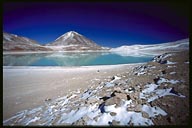 |
From Uyuni I took a bus to Potosí, at about 4,100 metres (13,450 ft), supposedly the highest city of its size anywhere. Potosí is an interesting town, founded in the 16th century (as almost all of these towns/cities were) around a very rich silver mine. The size of the mining operation was such that Potosí was once the biggest and wealthiest city in Latin America and supported the extravagance of the Spanish crown for two centuries. The bastard Spaniards apparently drove 8 million to their death in their lust for Potosí's silver. The mining continues today on Cerro Rico, a hill which towers over Potosí but the silver is depleted and today they mine mainly for tin, zinc, lead, antimony and tungsten.
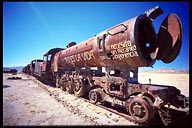 |
A tour of the mines takes you into Cerro Rico through a maze of tunnels and shafts. Before entering, you are expected to buy the miners gifts of coca leaves or explosives - I bought dynamite, fuse and ammonium nitrate which we later gave to the miners. We were given crappy old carbide lamps to guide us through the tunnels but they worked surprisingly well. On entering the tunnels, I first felt most uncomfortable leaving the daylight behind but was then OK despite having to crawl through some very tight passages. The mining techniques are very primitive, probably little different from those used 450 years ago. Young men and children chew up a ball of coca leaves which they retain in their mouth to help them overcome fatigue and bash away at the rock with hammers and steel spikes. The ore is all transported manually by wheelbarrow or back mounted sack to the outside. The heavy physical work at 4,200 metres (13,780 ft) in poorly ventilated tunnels is very tough on the poor bastards but they seemed happy enough.
 |
We
stopped at several shrines where the miners make gifts of coca leaves,
cigarettes and alcohol to a devil statue, referred to as El Tío (uncle).
Their alcohol, referred to as Whisky Boliviano, is just very strong industrial,
potable alcohol sold very cheaply in plastic bottles. Thank god that stuff
is not available at home!
The Casa de Moneda
in Potosí where they produced silver coins for about 400 years had some
amazing ancient machinery for milling the silver. The cool, dry atmosphere
of Potosí is obviously good for preserving the many religious paintings
from the 16th and 17th centuries on display and the mummified remains
of children from colonial and pre-colonial Inca periods. From Potosí,
Kristof and I traveled on to Sucre, another colonial city with a pleasant
atmosphere at a slightly lower and warmer altitude.
Sucre was relaxing but it doesn't seem to have any must-see attractions. Instead, in the couple of days I stayed there I got my dose of Bolivian (maybe South American) churches and museums.
Sucre is probably a pretty good place to do this as it is an important and well preserved colonial city. The cathedral and associated museum were full of art and treasure - good examples of the huge amounts of money squandered in the name of something nonexistent.
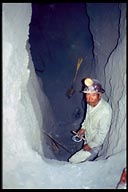 |
The Iglesia de la
Recoletta and its museum were interesting too. Sucre still has some status
as one of the national capitals but only in that the supreme court is
located there. Still, there's a lot more Bolivian history to see there
than in La Paz, particularly at the Casa de la Libertad where Bolivian
independence was declared in 1825. There I got a dose of Bolivian and
South American history.
Bolivia is now described as a democracy but the current president, Banzer,
was a repressive military dictator in the 70's and I suspect that his
present democratic rule is little more than a sham. It is however surprising
the amount of freedom which the press seems to have in criticising the
government and the people certainly aren't shy when it comes to protesting.
Demonstrations seem to occur with great regularity and mobs of police
with riot shields, tear gas guns and other weapons are a regular sight
around the streets of La Paz.
 |
Back in La Paz after
Sucre, it was time to do something about my 30 day permit for Bolivia
which had nearly run out. I could have paid for an extension but elected
to go to Peru for a day and then re-enter Bolivia to get another 30 days.
My departure from La Paz was nearly foiled (again) by demonstrations blocking
the road out of town. However, by taking the slum tour route through a
labyrinth of back streets we managed to avoid the blockade and were eventually
chugging our way across the altiplano towards Lake Titicaca.
The lake is quite a picturesque thing - and damn big. From some viewpoints
you gaze at a horizon of nothing but water. It looks quite a bit like
parts of the eastern Mediterranean with arid, rocky land surrounding the
deep blue sea. On a short ferry crossing I scanned the depths for diving
potential and thought a dive there would have been quite interesting.
Viz looked like about 50 feet but at 10°C it's cold and you'd have
to use some tricky dive tables for the high altitude (3,820 metres or
12,530 ft).
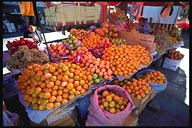 |
I stayed just one
night in Puno (Peru) before jumping on a bus back to La Paz. I thought
they might give me a hard time at the border but had no problems re-entering
Bolivia.
I then found myself back in La Paz, wanting to head off to Rurrenabaque
to do jungle and pampas tours but with a problem. I had been emailing
my mother for a week regarding my father who was very sick at home. After
a few more days of regular correspondence I received the worst news and
within 24 hours was on the first plane of several on my way back to New
Zealand.
The travel would resume after a break of about two weeks in New Zealand...
go to Skip en Sudamérica
- Part 2
Photographic Notes:
All photographs were taken with a Nikon F601 with either 50mm f1.8 or
18mm f3.5 manual focus Nikkor lenses. A 72mm Nikon polarizing filter was
sometimes used with the 18mm lens. Film used was mainly Fujichrome Sensia
II (100 ASA) with some Ektachrome E100VS. Images presented here were scanned
onto Kodak Photo CD and treated with Adobe Photoshop 5.5 using automatic
level adjustment and an unsharp mask filter.
© 2001 ianskipworth.com